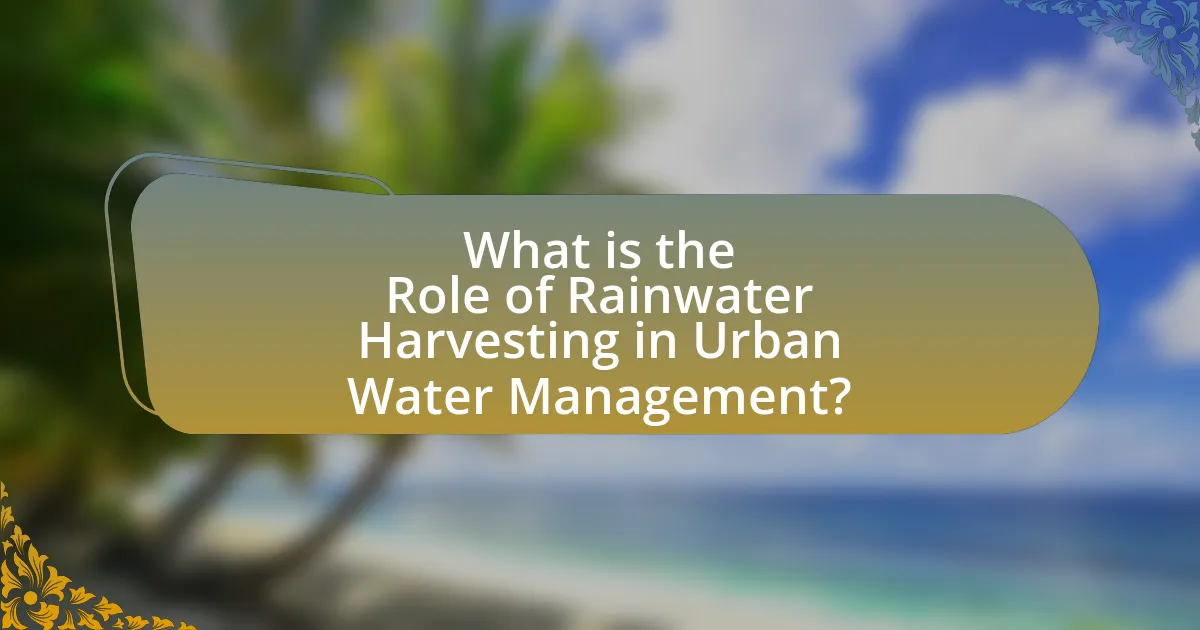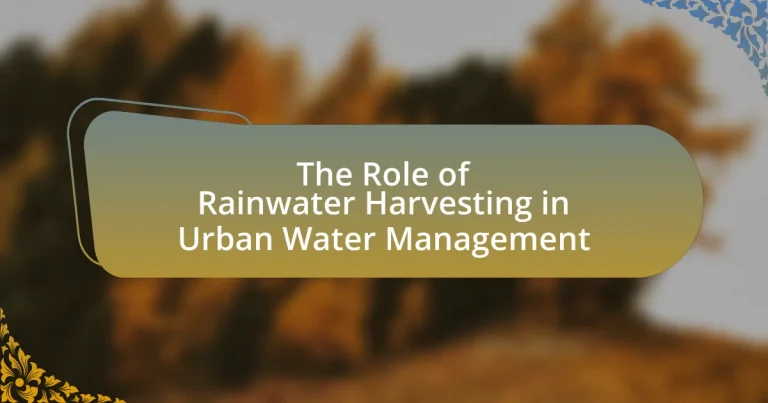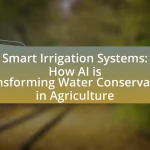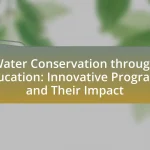Rainwater harvesting is a vital component of urban water management, offering an alternative water source that reduces dependence on traditional supply systems. This practice captures and stores rainwater for various applications, including irrigation and toilet flushing, significantly alleviating pressure on municipal resources. The article explores the mechanisms of rainwater harvesting, its environmental benefits, challenges faced in urban settings, and the importance of regulatory frameworks and public awareness in promoting its adoption. Additionally, it discusses best practices for effective implementation and the role of innovative technologies in enhancing system efficiency, ultimately contributing to sustainable urban development and improved water security.

What is the Role of Rainwater Harvesting in Urban Water Management?
Rainwater harvesting plays a crucial role in urban water management by providing an alternative source of water that reduces reliance on traditional supply systems. This method captures and stores rainwater for various uses, such as irrigation, toilet flushing, and even potable water, thereby alleviating pressure on municipal water resources. According to the United Nations, urban areas can reduce their water demand by up to 30% through effective rainwater harvesting systems. Additionally, these systems help mitigate urban flooding by managing stormwater runoff, which can lead to infrastructure damage and water pollution. By integrating rainwater harvesting into urban planning, cities can enhance water security, promote sustainability, and improve resilience against climate change impacts.
How does rainwater harvesting contribute to urban water supply?
Rainwater harvesting significantly enhances urban water supply by capturing and storing rainwater for various uses, thereby reducing reliance on traditional water sources. This method can provide up to 50% of a household’s water needs in urban areas, as demonstrated by studies showing that cities implementing rainwater harvesting systems can alleviate pressure on municipal water supplies. For instance, in cities like Bangalore, India, rainwater harvesting has been mandated in new constructions, leading to a notable increase in local water availability and a decrease in groundwater depletion.
What are the key components of a rainwater harvesting system?
The key components of a rainwater harvesting system include catchment areas, storage tanks, conveyance systems, and filtration systems. Catchment areas, typically roofs, collect rainwater, which is then directed through conveyance systems like gutters and downspouts to storage tanks. Storage tanks hold the collected rainwater for later use, while filtration systems ensure the water is clean and safe for consumption or irrigation. These components work together to efficiently capture and utilize rainwater, contributing to sustainable urban water management practices.
How is rainwater collected and stored in urban settings?
Rainwater is collected in urban settings primarily through systems that capture runoff from rooftops and paved surfaces. These systems typically include gutters and downspouts that direct water into storage tanks or cisterns. In many cities, rainwater harvesting systems are designed to maximize collection efficiency, often incorporating features like first-flush diverters to ensure that the initial, potentially contaminated runoff is excluded from storage.
Stored rainwater can be utilized for non-potable purposes such as irrigation, toilet flushing, and cooling systems, thereby reducing the demand on municipal water supplies. According to the U.S. Environmental Protection Agency, rainwater harvesting can significantly alleviate stormwater runoff and improve water quality in urban environments.
Why is rainwater harvesting important for sustainable urban development?
Rainwater harvesting is important for sustainable urban development because it effectively reduces reliance on traditional water sources, mitigates flooding, and promotes water conservation. By capturing and utilizing rainwater, urban areas can decrease the demand on municipal water supplies, which is crucial as urban populations grow. According to the United Nations, cities are expected to house 68% of the world’s population by 2050, increasing the pressure on existing water resources. Furthermore, rainwater harvesting systems can help manage stormwater runoff, reducing the risk of urban flooding and improving water quality by filtering pollutants. This dual benefit supports the resilience of urban infrastructure and enhances environmental sustainability.
What environmental benefits does rainwater harvesting provide?
Rainwater harvesting provides significant environmental benefits, including the reduction of stormwater runoff and the conservation of natural water resources. By capturing and utilizing rainwater, this practice decreases the volume of water that flows into drainage systems, which can help mitigate flooding and reduce erosion in urban areas. Additionally, rainwater harvesting lessens the demand on groundwater and surface water sources, promoting sustainable water management. Studies indicate that implementing rainwater harvesting systems can lead to a reduction in urban flooding by up to 50%, demonstrating its effectiveness in enhancing urban resilience and protecting local ecosystems.
How does rainwater harvesting help in reducing urban flooding?
Rainwater harvesting helps in reducing urban flooding by capturing and storing rainwater, which decreases the volume of runoff entering drainage systems. This method mitigates the risk of overwhelming stormwater infrastructure during heavy rainfall events. Studies indicate that implementing rainwater harvesting systems can reduce peak runoff by up to 50%, thereby lowering the likelihood of flooding in urban areas. Additionally, rainwater harvesting promotes groundwater recharge, which further aids in managing excess water and maintaining hydrological balance in urban environments.

What challenges does rainwater harvesting face in urban areas?
Rainwater harvesting in urban areas faces several challenges, including limited space for installation, regulatory barriers, and contamination risks. Urban environments often have high population densities, which restrict available areas for rainwater collection systems. Additionally, local regulations may not support or may complicate the implementation of such systems, creating obstacles for homeowners and developers. Furthermore, urban runoff can introduce pollutants into collected rainwater, raising concerns about water quality and safety for non-potable uses. These factors collectively hinder the widespread adoption and effectiveness of rainwater harvesting in cities.
What are the common barriers to implementing rainwater harvesting systems?
Common barriers to implementing rainwater harvesting systems include high initial costs, lack of public awareness, regulatory challenges, and technical limitations. High initial costs can deter potential adopters, as installation and maintenance require significant investment. Lack of public awareness leads to insufficient demand and understanding of the benefits of rainwater harvesting. Regulatory challenges arise from inconsistent policies and building codes that may not support or incentivize such systems. Technical limitations, such as inadequate infrastructure or knowledge about system design and maintenance, further hinder implementation. These barriers collectively impede the widespread adoption of rainwater harvesting systems in urban water management.
How do regulatory frameworks impact rainwater harvesting initiatives?
Regulatory frameworks significantly influence rainwater harvesting initiatives by establishing guidelines that dictate the design, implementation, and maintenance of such systems. These frameworks can either promote or hinder the adoption of rainwater harvesting through incentives, permits, and compliance requirements. For instance, in regions where regulations support rainwater harvesting, such as California, policies provide tax credits and rebates, leading to increased installations and community engagement. Conversely, in areas with restrictive regulations, such as stringent building codes or lack of incentives, the uptake of rainwater harvesting systems may be minimal. This demonstrates that effective regulatory frameworks are crucial for fostering sustainable urban water management practices.
What are the financial challenges associated with rainwater harvesting?
The financial challenges associated with rainwater harvesting include high initial installation costs, ongoing maintenance expenses, and potential regulatory fees. The installation of rainwater harvesting systems can require significant upfront investment, often ranging from several hundred to several thousand dollars, depending on the complexity and scale of the system. Additionally, maintenance costs can accumulate over time, as regular upkeep is necessary to ensure system efficiency and compliance with health standards. Furthermore, some municipalities impose fees or require permits for rainwater harvesting systems, adding to the overall financial burden. These factors can deter individuals and organizations from adopting rainwater harvesting solutions despite their long-term benefits.
How can public awareness and education improve rainwater harvesting adoption?
Public awareness and education can significantly improve rainwater harvesting adoption by informing communities about its benefits and practical implementation. Increased knowledge leads to greater acceptance and motivation to adopt rainwater harvesting systems, as individuals understand how these systems can reduce water bills, alleviate pressure on municipal water supplies, and contribute to environmental sustainability. For instance, a study by the International Rainwater Harvesting Alliance found that communities with educational programs on rainwater harvesting saw a 30% increase in adoption rates compared to those without such initiatives. This demonstrates that targeted education can effectively drive the implementation of rainwater harvesting practices in urban settings.
What role do community programs play in promoting rainwater harvesting?
Community programs play a crucial role in promoting rainwater harvesting by educating residents about its benefits and providing resources for implementation. These programs often facilitate workshops, distribute informational materials, and offer technical assistance, which empowers individuals and communities to adopt rainwater harvesting systems. For instance, a study by the International Rainwater Harvesting Alliance found that communities engaged in educational programs saw a 30% increase in rainwater harvesting installations within two years. This demonstrates that community initiatives not only raise awareness but also lead to tangible increases in the adoption of sustainable water management practices.
How can educational campaigns effectively inform urban residents about rainwater harvesting?
Educational campaigns can effectively inform urban residents about rainwater harvesting by utilizing targeted messaging, community engagement, and practical demonstrations. Targeted messaging ensures that information is relevant to the specific needs and concerns of urban populations, highlighting benefits such as cost savings and environmental impact. Community engagement fosters a sense of ownership and responsibility, encouraging residents to participate in workshops and local initiatives. Practical demonstrations, such as installing rainwater harvesting systems in public spaces, provide tangible examples that residents can replicate at home. Studies show that communities with hands-on educational programs see a 30% increase in rainwater harvesting adoption rates, illustrating the effectiveness of these strategies.

What are the best practices for effective rainwater harvesting in urban environments?
The best practices for effective rainwater harvesting in urban environments include designing systems that maximize collection efficiency, ensuring proper filtration and storage, and implementing maintenance protocols. Efficient design involves using appropriate catchment surfaces, such as roofs, and integrating gutters and downspouts that direct water to storage tanks. Proper filtration is essential to remove debris and contaminants, which can be achieved through sedimentation tanks or mesh filters. Regular maintenance, including cleaning gutters and inspecting storage tanks, ensures the system operates effectively and safely. According to the United Nations, urban areas can reduce stormwater runoff by up to 50% through effective rainwater harvesting practices, demonstrating the significant impact of these methods on urban water management.
How can urban planners integrate rainwater harvesting into city designs?
Urban planners can integrate rainwater harvesting into city designs by incorporating systems that collect and store rainwater from rooftops and other surfaces for reuse. This can be achieved through the installation of rainwater collection tanks, permeable pavements, and green roofs, which not only capture rainwater but also reduce runoff and improve urban drainage. Studies show that cities implementing rainwater harvesting can reduce their reliance on potable water sources by up to 50%, thereby enhancing water sustainability and resilience against droughts.
What types of rainwater harvesting systems are most effective for urban use?
The most effective types of rainwater harvesting systems for urban use include rooftop collection systems, underground storage tanks, and rain gardens. Rooftop collection systems utilize building rooftops to capture rainwater, which is then directed into storage tanks for later use, significantly reducing stormwater runoff and providing a supplemental water source. Underground storage tanks are effective in urban areas where space is limited, allowing for large volumes of rainwater to be stored out of sight and used for irrigation or non-potable applications. Rain gardens, designed to absorb and filter rainwater, enhance urban green spaces while managing stormwater effectively. These systems collectively contribute to sustainable urban water management by mitigating flooding, reducing reliance on municipal water supplies, and improving water quality.
How can maintenance practices enhance the efficiency of rainwater harvesting systems?
Maintenance practices enhance the efficiency of rainwater harvesting systems by ensuring optimal functionality and longevity of the components involved. Regular inspections and cleaning of gutters, filters, and storage tanks prevent blockages and contamination, which can significantly reduce water quality and collection efficiency. For instance, a study by the University of Queensland found that systems with routine maintenance had a 30% higher water collection efficiency compared to those that were neglected. Additionally, timely repairs of leaks and structural issues prevent water loss, further maximizing the system’s effectiveness.
What innovative technologies are emerging in rainwater harvesting?
Innovative technologies emerging in rainwater harvesting include smart sensors, advanced filtration systems, and integrated management software. Smart sensors enable real-time monitoring of rainwater levels and quality, optimizing collection and usage. Advanced filtration systems enhance the purity of harvested water, making it suitable for various applications. Integrated management software allows for efficient data analysis and resource allocation, improving overall system performance. These technologies collectively contribute to more efficient and sustainable urban water management practices.
How do smart technologies improve rainwater management?
Smart technologies enhance rainwater management by utilizing data analytics, IoT sensors, and automated systems to optimize collection and distribution. These technologies enable real-time monitoring of rainfall patterns and water levels, allowing for efficient storage and usage of harvested rainwater. For instance, smart rainwater harvesting systems can automatically adjust storage capacities based on predictive weather analytics, ensuring maximum efficiency and reducing overflow risks. Studies have shown that cities implementing smart rainwater management systems can increase water conservation by up to 30%, demonstrating the effectiveness of these technologies in urban water management.
What role does data analytics play in optimizing rainwater harvesting systems?
Data analytics plays a crucial role in optimizing rainwater harvesting systems by enabling the collection, analysis, and interpretation of data related to rainfall patterns, water quality, and system performance. By utilizing historical weather data and real-time monitoring, data analytics helps in predicting water availability and optimizing storage capacities, which can lead to more efficient water usage and reduced waste. For instance, studies have shown that implementing data-driven decision-making can increase the efficiency of rainwater harvesting systems by up to 30%, as it allows for tailored designs and operational strategies based on specific environmental conditions.
What practical steps can urban residents take to implement rainwater harvesting?
Urban residents can implement rainwater harvesting by installing a rainwater collection system, which typically includes gutters, downspouts, and storage tanks. First, residents should assess their roof area to determine the potential volume of rainwater that can be collected; for example, a 1,000 square foot roof can yield approximately 600 gallons of water from just one inch of rainfall. Next, they should install gutters and downspouts to channel rainwater into a storage tank, ensuring that the system is properly sealed to prevent contamination. Additionally, residents can use filtration systems to purify the collected water for non-potable uses, such as irrigation or toilet flushing. Local regulations may require permits or adherence to specific guidelines, so checking with municipal authorities is essential. Implementing these steps not only conserves water but also reduces stormwater runoff, contributing to better urban water management.


